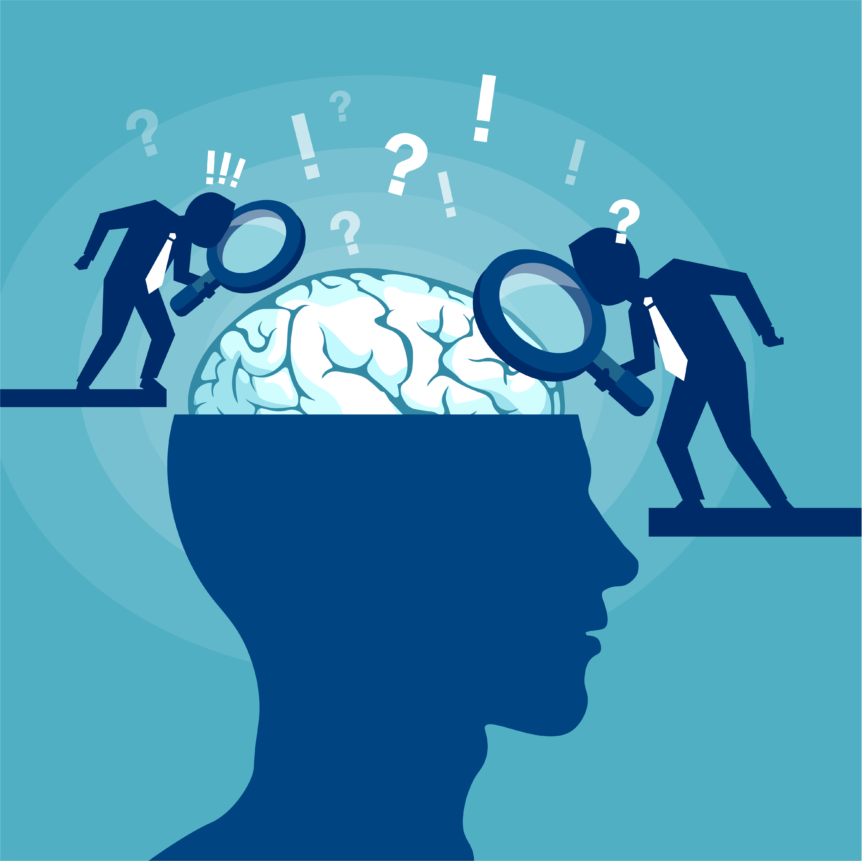Dietary factors have the ability to benefit or impair multiple aspects of our health. There is an abundance of literature analyzing relationships between diet and body mass, cardiovascular function, glucose regulation, and other health measures. As we put the pieces together, interest in diet and brain has developed into its own sub-field within the study of nutrition. For those of us who want to pursue research in this field, it is important to consider the foundation by which we assess these relationships. We’ve written about how prebiotics can affect cognition before, but how can we assess cognition in the first place?
What is cognitive function?
Crudely put, it’s all of those intangible things the brain does behind-the-scenes like decision making, reasoning, thinking, learning, and more. Those could be further broken down into components like memory, attention, and inhibitory control. One is hard-pressed to give a succinct definition, as cognitive neuroscience has grown into its own field.
In the lab, we can assess cognitive function both broadly, encompassing multiple domains, and with more specific assessments of a few of these functions. It’s tempting to try and boil down cognition into something easy to measure and discuss like IQ or “brain health”, but these are so vague they provide little value. Here we want to provide our perspective on balancing methods that capture broad vs specific functions.
Cognitive function is relative
“While global cognitive assessments can be useful… a more domain specific assessment yields greater precision…
Before considering a cognitive assessment tool, we must first consider our definition of cognitive “health”. Good cognitive health could be defined as optimal cognitive function. The question becomes, optimal for what? In an aging population, optimal may be defined as normal function with no evidence of dementia. However, in younger populations we may consider those who are above average on certain mental skills to be more cognitively healthy than others. Our understanding and evaluation of cognitive health is far more nuanced than this.
While global cognitive assessments can be useful to assess gross abilities of those who fall in an above average category of creative thinking or reasoning, a more domain specific assessment yields greater precision to identify smaller changes that contribute to global decline in cognition but may not be detectible with a lower resolution test.
Aging populations provide a great framework for how to assess cognitive health with regard to nutrition. Johnson et al.1 and Hammond et al.2 exemplify proper utilization of global and domain specific cognitive assessments, respectively. Johnson et al.1 recruited 78 octogenarians and over 200 centenarians to study carotenoids and cognitive function. Of these participants, 47 volunteered to provide brain samples after death for further analysis. Subjects were tested on a battery of 10 global cognitive assessments. The idea is that by utilizing a wide breadth of tasks, the researchers could capture potential cognitive changes in relation to nutrition status both within a task and across tasks.
Global Tasks
Some global assessment tools attempt to replicate real life scenarios in which cognitive abilities are employed. Johnson et al.1 used a task called the Mini-Mental State Exam (MMSE). One portion of the MMSE provides participants with a short list of words at the beginning of the assessment. Later in the assessment, these words must be recalled in the same order that they were read. You can imagine that this is similar to scenarios you could encounter in daily life, like remembering items of a grocery list or names of new acquaintances, perhaps. Using this task, Johnson et al.1 found a significant positive relationship between lutein concentration in the cortex and performance on the MMSE. This relationship didn’t exist for other carotenoids like zeaxanthin or β-carotene, however. You can imagine then that using multiple global tasks like the MMSE and measuring metabolites in the brain might help you clue in on which metabolites or functions are most closely related.
While a global measure of cognition can provide ample data in our understanding of cognition as a whole, often it can result in oversight of changes in deeper, underlying cognitive processes. These distinct processes could be captured with a domain-specific task; however, it is difficult to choose what will capture enough to answer your research question. Often, the use of a more specific task may require additional equipment or expertise within a subject area for proper application and analysis. Thus, without collaboration or funds for these assessments, more specific cognitive functions can often be overlooked within a study. This is where risk comes into play and it’s easy to become fearful that you might put all of your eggs in one basket trying to deeply understand a specific function, when you could have cast a wider net with a simpler, global tool.
In the study by Johnson et al.1 we see where a more domain-specific task could have benefited the researchers, specifically related to the cerebellum. The cerebellum is a region of the brain which is responsible for, most notably, motor skills as well as non-motor cognitive functions. In their study, Johnson et al.1 found that macular lutein was related to cerebellar lutein, however, there were no associations found between cerebellar lutein and cognitive function. On the other hand, Renzi et al.3 found that balance and visual-motor responses were indeed related to macular lutein. While this study was not able to quantify lutein concentrations in the cerebellum it is hypothesized to be relevant for these results. Had Johnson et al.1 utilized a task more closely tied to the cerebellum, it is possible they would have observed a significant relationship with cerebellar lutein.
Domain-specific tasks
The drawback to a global task, however, is that it provides lower resolution for observing changes in cognition. In contrast, Hammond et al.2 used domain-specific tasks to measure cognitive changes after lutein supplementation. The researchers completed a year-long randomized controlled trial with 80 adults with an average age of 73. Participants consumed either a placebo or a supplement containing lutein + zeaxanthin every day. While the researchers also used a wide array of cognitive assessments, there was a larger proportion of domain-specific assessments rather than global tests. For example, a domain called “Complex Attention” was assessed using the shifting attention task (SAT), the Stroop Test, and the Continuous Performance Task. That sounds like a lot of technical jargon, which it is. The point however is the combination of multiple domain specific tasks allowed the researchers to assess domains like attention and cognitive flexibility. They ultimately found that participants with higher levels of retinal carotenoids also tended to see the greatest improvements in cognitive performance before and after supplementation with carotenoids.
These results indicate that a higher resolution task can provide us the ability to better understand the influence of our nutrient of interest on a variety of realms of cognition which make up every-day function.
Which tools should you use?
To some scientists, especially those familiar with cognitive testing, the above distinctions are painfully obvious. With the time and resources, we should of course be using the most precise and state-of-the-art methods and tools to measure the outcome variables of interest. It’s of course more fun to use an MRI, EEG, or one of your other favorite tools.
In practice, there can be very real limitations to the use of these tools. Time, cost, personnel, and subject participation should be considered. Even with all of the money and time necessary, if subjects are not willing or able to participate in complex and domain-specific tasks, this presents clear issues. When time and money are limiting factors, it is unreasonable to expect the latest and greatest methods to be used.
We think the methods that lead to the greatest chance of success should be used. In other words, use the methods that are within reason and importantly within your grasp to execute well. Conduct a literature review, identify what others have already discovered, and leverage their results to design your study. Fit the tool to the task, not the other way around.
Global assessments might appear “more realistic” to a task subjects do in their real lives, but this comes at the sacrifice of both sensitivity and precision. Domain-specific tasks are typically more precise, even though they might appear to have less similarity to everyday activities a subject engages in. Both may be accurate; the important distinction is the sensitivity and precision of each approach. If you want precision, which two distributions would you like to see in your control and test populations? Probably the ones with the clearest difference between them.
To sum up:
- Global tasks
- Frequently replicate “real-life” situations
- Are easy to use
- Lack precision
- Domain-specific tasks
- Provide greater precision and sensitivity
- May require greater expertise and resources.


About the authors:
Corinne Cannavale is a PhD candidate in the Body Composition and Nutritional Neuroscience lab at University of Illinois at Urbana-Champaign. Corinne’s main research interests are in learning and memory and how memory can be modulated through different health behaviors. Her main research projects are in understanding how diet and obesity-related chronic inflammation can impact memory function. Connect with her on LinkedIn.
Stephen Fleming is President and Co-founder of Traverse Science. He believes science doesn’t have to be hard and should accelerate business, not slow it down. He has a background in neuroscience and nutrition from the University of Illinois at Urbana-Champaign where he studied oligosaccharide intake and brain development for his PhD. If you want to learn more, follow him and Traverse Science on LinkedIn, and connect with us at engage@traversescience.com.
About the company: Traverse Science is a nutrition consulting firm working with ingredient suppliers and consumer packages goods companies in the human and animal nutrition space. We work with clients to get science done, whether that means organizing and conducting a study, analyzing new or long-forgotten data, or writing a manuscript for peer review or guidance document for internal use. As teams change, time runs short, or projects pivot, we provide the muscle and the know-how to finish your nutrition science and get your projects out the door – whatever that means for you. We believe that science doesn’t have to be hard, and we’re here to make it easy.
Works Cited
- Johnson EJ, Vishwanathan R, Johnson MA, Hausman DB, Davey A, Scott TM, Green RC, Miller LS, Gearing M, Woodard J, et al. Relationship between Serum and Brain Carotenoids, α -Tocopherol, and Retinol Concentrations and Cognitive Performance in the Oldest Old from the Georgia Centenarian Study. Journal of Aging Research. 2013;2013:1–13. doi:10.1155/2013/951786
- Hammond BR, Miller LS, Bello MO, Lindbergh CA, Mewborn C, Renzi-Hammond LM. Effects of Lutein/Zeaxanthin Supplementation on the Cognitive Function of Community Dwelling Older Adults: A Randomized, Double-Masked, Placebo-Controlled Trial. Frontiers in Aging Neuroscience. 2017;9:254. doi:10.3389/fnagi.2017.00254
- Renzi LM, Bovier ER, Hammond BR. A role for the macular carotenoids in visual motor response. Nutritional Neuroscience. 2013;16(6):262–268. doi:10.1179/1476830513y.0000000054

